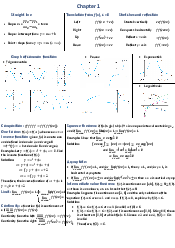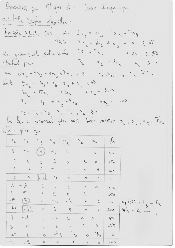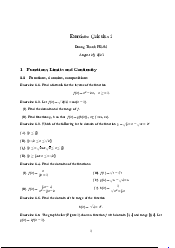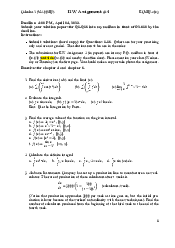


Preview text:
CALCULUS 1
Solutions for Final Examination Question 1. f (x) = x2e−2x. (a)
f 0(x) = 2xe−2x − 2x2e−2x = 2xe−2x(1 − x).
The increasing/decresing intervals are given in the following chart. x 0 1 f 0(x) - 0 + 0 - f (x) & % &
(b) According to part (a), f has local maximum f (1) = e−2 and local minimum value f (0) = 0.
(c) f 0(x) = 2(x − x2)e−2x.. So
f ”(x) = 2(1 − 2x)e−2x − 4(x − x2)e−2x = 2(1 − 4x + 2x2)e−2x, √ √
which has the same sign as p(x) = 1−4x+2x2. Since p(x) = 0 iff x = 1− 2/2 < x < 1+ 2/2, √ √
and p(x) < 0 iff 1 − 2/2 < x < 1 + 2/2, the f(x) is concave upward in the intervals √ √ √ √
x < 1− 2/2 and x > 1+ 2/2, and concave downward in the interval 1− 2/2 < x < 1+ 2/2. √ √ √
The graph of f has two inflection points: (1 ± 2/2, (3/2 ± 2)e−2∓ 2).
(d) Sketch the graph of f , see Figure 1.
Figure 1: Graph of f (x) = x2e−2x in Question 1
Question 2. a) Let y = 1 − sin 1 2x. Then x 1 lim ln y = lim 2x ln 1 − sin x→∞ x→∞ x ln 1 − sin 1 = 2 lim x x→∞ 1/x
(− cos(1/x)(−1/x2)/(1 − sin(1/x)) = 2 lim x→∞ −1/x2 − cos(1/x) = 2 lim = −2. x→∞ 1 − sin(1/x) Thus, lim y = 1/e2. x→∞ 1
b) Let f (x) = 2x − 1 − sin(x). We use Newton’s method with starting point x0 = 1 to find the root of f (x) = 0. f (x ) 2x − 1 − sin(x ) x − n = x − n n , n+1 = xn f n 0(x ) 2 ) n − cos(xn which gives us
x1 = 0.891395995328754, x2 = 0.887865749400352, x3 = 0.887862211574412, x4 = 0.887862211570866
Question 3. Evaluate the integrals a) Z 2 Z 2 I = x2 ln(x3)dx = ln xdx3 1 1 2 Z 2 = x3 ln x − x3(1/x)dx 1 1 Z 2 2 = 8 ln 2 −
x2dx = 8 ln 2 − x3/3 = 8 ln 2 − 7/3 = 3.2118. 1 1 √ b) Set u = ln x, dv = 1 √ dx. Then, du = dx/x, v = 2 x. Thus x √ Z e ln x √ e Z e 2 x √ dx = (ln x)2 x − dx x 1 x 1 1 √ Z e 2 = 2 e − √ dx x 1 √ √ e √
= 2 e − 4 x = −2 e + 4 = 0.7026 1 Question 4. Z ∞ ln x Z ∞ −1 dx = ln xd x 1 x2 1 − ln x∞ Z ∞ 1 = + dx x 1 x2 1 1 ∞ = 0 − = 1. x 1 (b) x + e−x 1 > , x ≥ 1 x2 x
The integral R ∞(1/x)dx is divergent, therefore, the given integral is also divergent, by Com- 1 parison Test.
Question 5. (a) The equation 2 − x − (x2 − 2x) = (2 − x)(x + 1) = 0 gives intersection points at x = −1, x = 2. Area: Z 2 Z 2 A = (2 − x − (x2 − 2x))dx = (2 + x − x2)dx −1 −1 2 = (2x + x2/2 − x3/3) = 9/2 −1 2
Figure 2: Area in Question 5, (a)
(b) y = sin(x), 0 ≤ x ≤ π, and y = 0 about the line x = 4. Radius: R = 4−x, circumference
2π(4 − x), and height sin x. So, Z π π Z π V =
2π(4 − x) sin xdx = −8π cos x + 2πxd cos x 0 0 0 π Z π = 16π + 2π(x cos x − cos xdx) 0 0 π
= 16π + 2π(−π − sin x ) = 16π − 2π2 = 30.5263 0 3




